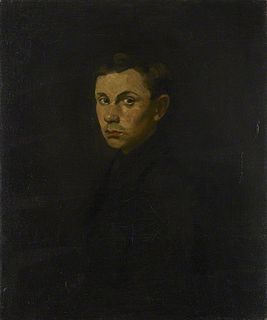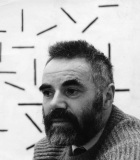Related Research Articles

Installation art is an artistic genre of three-dimensional works that are often site-specific and designed to transform the perception of a space. Generally, the term is applied to interior spaces, whereas exterior interventions are often called public art, land art or art intervention; however, the boundaries between these terms overlap.

The Turner Prize, named after the English painter J. M. W. Turner, is an annual prize presented to a British visual artist. Between 1991 and 2016, only artists under the age of 50 were eligible. The prize is awarded at Tate Britain every other year, with various venues outside of London being used in alternate years. Since its beginnings in 1984 it has become the UK's most publicised art award. The award represents all media.

Vorticism was a London-based modernist art movement formed in 1914 by the writer and artist Wyndham Lewis. The movement was partially inspired by Cubism and was introduced to the public by means of the publication of the Vorticist manifesto in Blast magazine. Familiar forms of representational art were rejected in favour of a geometric style that tended towards a hard-edged abstraction. Lewis proved unable to harness the talents of his disparate group of avant-garde artists; however, for a brief period Vorticism proved to be an exciting intervention and an artistic riposte to Marinetti's Futurism and the post-impressionism of Roger Fry's Omega Workshops.
Christopher Ofili, is a British Turner Prize-winning painter who is best known for his paintings incorporating elephant dung. He was one of the Young British Artists. Since 2005, Ofili has been living and working in Trinidad and Tobago, where he currently resides in Port of Spain. He also lives and works in London and Brooklyn.
Marc Quinn is a British contemporary visual artist whose work includes sculpture, installation, and painting. Quinn explores "what it is to be human in the world today" through subjects including the body, genetics, identity, environment, and the media. His work has used materials that vary widely, from blood, bread and flowers, to marble and stainless steel. Quinn has been the subject of solo exhibitions at Sir John Soane's Museum, the Tate Gallery, National Portrait Gallery, Fondation Beyeler, Fondazione Prada and South London Gallery. The artist was a notable member of the Young British Artists movement.

Benjamin Lauder Nicholson, OM was an English painter of abstract compositions, landscape and still-life.
Basil Beattie RA is a British artist, whose work revolves around abstraction and is known for its emotive and gestural forms.

Sir Alan Bowness CBE was a British art historian, art critic, and museum director. He was the director of the Tate Gallery between 1980 and 1988.
Matthew Collings is a British art critic, writer, broadcaster, and artist. He is married to Emma Biggs, with whom he collaborates on art works.

Edwin John Victor Pasmore, CH, CBE was a British artist. He pioneered the development of abstract art in Britain in the 1940s and 1950s.

Shirazeh Houshiary is an Iranian sculptor, installation artist, and painter. She lives and works in London.

Lucio Muñoz was a Spanish abstract painter and engraver.

Gregory Stephen Tate was an American writer, musician, and producer. A long-time critic for The Village Voice, Tate focused particularly on African-American music and culture, helping to establish hip-hop as a genre worthy of music criticism. Flyboy in the Buttermilk: Essays on Contemporary America (1992) collected 40 of his works for the Voice and he published a sequel, Flyboy 2, in 2016. A musician himself, he was a founding member of the Black Rock Coalition and the leader of Burnt Sugar.
Matt Bryans is an artist based in London. Bryans has exhibited at Tate Modern in the exhibition Untitled (2005), with Amie Dicke, Godfried Donkor, Dr Lakra, Wangechi Mutu, Jockum Nordström, Stephen Shearer and Nicole Wermers. He erases colour photographs from magazines, leaving behind smudged and smeared newsprint. Such collections of masked news stories covered the walls of galleries in immersive installations.
William Edward Gompertz was the BBC's arts editor before moving to a position as the Barbican Centre’s Artistic Director from 1 June 2021.
The year 2012 in art involves some significant events.
George Warner Allen (1916–1988) was a British artist, considered to be of the Neo-Romantic school.

Informalism or Art Informel is a pictorial movement from the 1943–1950s, that includes all the abstract and gestural tendencies that developed in France and the rest of Europe during the World War II, similar to American abstract expressionism started 1946. Several distinguishing trends are identified within the movement such as lyrical abstraction, matter painting, New Paris School, tachisme and art brut. The French art critic Michel Tapié coined the term "art autre" in the homonymous book published in 1952 in relation to non-geometric abstract art. It was instrumental in improving the concept of abstract art in France during the Early 1950s. Its use in the expression of political ideologies in South America during the Early 1950s was quite common, as it was seen as the main way to show support for the changing political climate.

Kate Whiteford OBE is a Scottish artist. Her work includes painting, screen prints, textiles, land art and installations.

Dove is a lithograph on paper created by Pablo Picasso in 1949 in an edition of 50+5. The lithograph displays a white dove on a black background, which is widely considered to be a symbol of peace. The image was used to illustrate a poster at the 1949 Paris Peace Congress and also became an iconographic image of the period, known as "The dove of peace". An example is housed in the collection of the Tate Gallery and MOMA. Since then, it has been considered a masterpiece.
References
- 1 2 Foster, Alicia (2004). Tate women artists. London: Tate. pp. 179–180. ISBN 9781854373113.